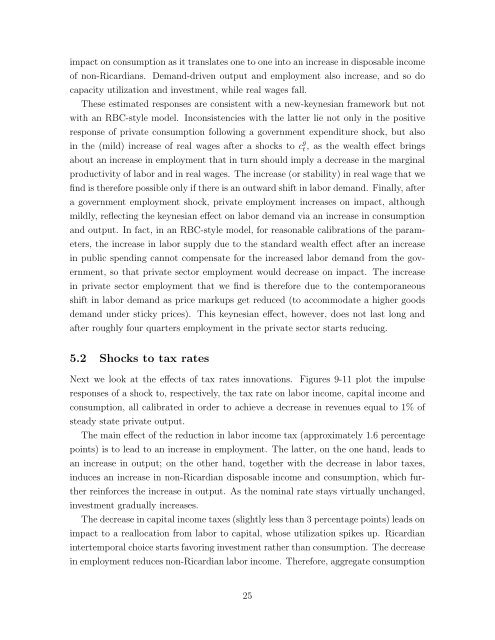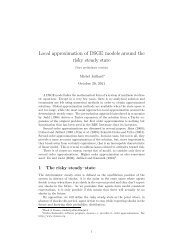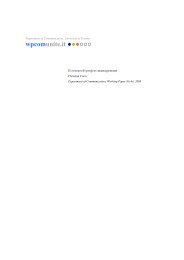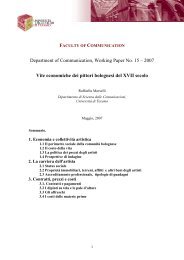The general equilibrium effects of fiscal policy
The general equilibrium effects of fiscal policy
The general equilibrium effects of fiscal policy
Create successful ePaper yourself
Turn your PDF publications into a flip-book with our unique Google optimized e-Paper software.
impact on consumption as it translates one to one into an increase in disposable income<strong>of</strong> non-Ricardians. Demand-driven output and employment also increase, and so docapacity utilization and investment, while real wages fall.<strong>The</strong>se estimated responses are consistent with a new-keynesian framework but notwith an RBC-style model. Inconsistencies with the latter lie not only in the positiveresponse <strong>of</strong> private consumption following a government expenditure shock, but alsoin the (mild) increase <strong>of</strong> real wages after a shocks to c g t , as the wealth effect bringsabout an increase in employment that in turn should imply a decrease in the marginalproductivity <strong>of</strong> labor and in real wages. <strong>The</strong> increase (or stability) in real wage that wefind is therefore possible only if there is an outward shift in labor demand. Finally, aftera government employment shock, private employment increases on impact, althoughmildly, reflecting the keynesian effect on labor demand via an increase in consumptionand output. In fact, in an RBC-style model, for reasonable calibrations <strong>of</strong> the parameters,the increase in labor supply due to the standard wealth effect after an increasein public spending cannot compensate for the increased labor demand from the government,so that private sector employment would decrease on impact. <strong>The</strong> increasein private sector employment that we find is therefore due to the contemporaneousshift in labor demand as price markups get reduced (to accommodate a higher goodsdemand under sticky prices). This keynesian effect, however, does not last long andafter roughly four quarters employment in the private sector starts reducing.5.2 Shocks to tax ratesNext we look at the <strong>effects</strong> <strong>of</strong> tax rates innovations. Figures 9-11 plot the impulseresponses <strong>of</strong> a shock to, respectively, the tax rate on labor income, capital income andconsumption, all calibrated in order to achieve a decrease in revenues equal to 1% <strong>of</strong>steady state private output.<strong>The</strong> main effect <strong>of</strong> the reduction in labor income tax (approximately 1.6 percentagepoints) is to lead to an increase in employment. <strong>The</strong> latter, on the one hand, leads toan increase in output; on the other hand, together with the decrease in labor taxes,induces an increase in non-Ricardian disposable income and consumption, which furtherreinforces the increase in output. As the nominal rate stays virtually unchanged,investment gradually increases.<strong>The</strong> decrease in capital income taxes (slightly less than 3 percentage points) leads onimpact to a reallocation from labor to capital, whose utilization spikes up. Ricardianintertemporal choice starts favoring investment rather than consumption. <strong>The</strong> decreasein employment reduces non-Ricardian labor income. <strong>The</strong>refore, aggregate consumption25





